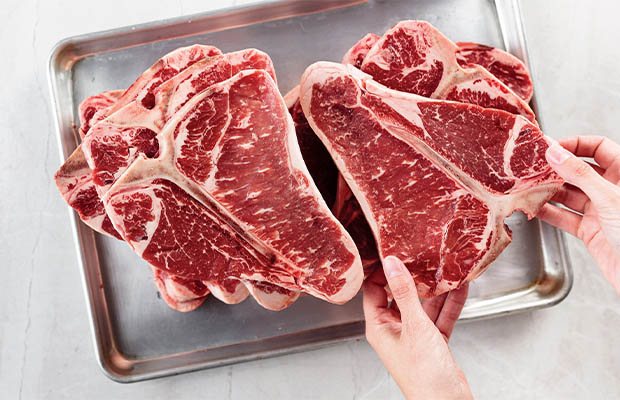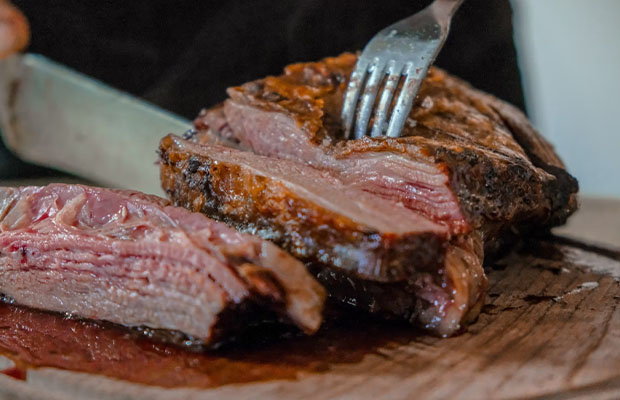You’ve come to the right place if you have steak in the fridge and are wondering how long it will keep and if it’s still good.
How long can steak stay in the fridge? Raw steak lasts anywhere from 3 days to two weeks in your refrigerator. Everything is based on the packaging.
Let’s cut right to the chase now for a nice change of pace from internet tradition!
Table of Contents
How Long Can Raw Steak Stay in the Fridge?
The USDA’s recommendation is three to five days if you can resist the urge to grill it and consume it right away; they care more about your health than they do about making money off of meat.
This answer assumes two things:
- Your steak is wrapped properly
- It’s stored below 40 °F, the low point of the so-called “Danger Zone” for bacteria growth
Most bacteria prefer temperatures between 40°F and 140°F to thrive. Bacteria can be controlled by keeping your raw steak below 40 degrees Fahrenheit, but this won’t permanently stop them or stop it from spoiling.

Whether you’re at the upper or lower end of the three to five day range depends on how well and in what material your steak is wrapped. However, before cooking raw meat, you should always thoroughly inspect it, regardless of how it was packaged.
The three typical steak packaging options are shown below.
If Vacuum Sealed
The USDA claims that vacuum sealing makes no difference. It does, say businesses that market vacuum-sealed meat and vacuum sealing equipment.
Vacuum-sealed raw steak has a shelf life of up to 10 days, according to claims.
Please understand that we do not advocate disobeying the USDA’s recommendations. But when you take any exposure to oxygen out of the equation, you can without a doubt anticipate reaching the upper end of the range.
If Cling Film Wrapped
Frequently, grocery store steak is packaged entirely in clear plastic and placed on those flimsy foam trays. They should, in theory, be completely anaerobic (lacking all oxygen; achieved through vacuum sealing, which involves sucking out the air), if not airtight enough to make no difference.
However, when being transported from the store or placed in the refrigerator, the thin plastic is easily torn. Therefore, even though you might get the full five days out of this method, I anticipate the average to be closer to the low end.
If Bought from the Butcher’s Counter
Butcher paper can be wrapped as tightly as plastic if done correctly. If it’s done wrong, your raw steak might as well be left on a plate unattended.
There is no reason your paper-wrapped steak shouldn’t be as good as new for the entire five days, assuming you went to the trouble of finding a good butcher because you love steak.
Related Reading:
- How To Cook Club Steak?
- How Long Does Broccoli Last in the Fridge?
- How Long Does Ramen Last in the Fridge?
What Happens When Steak Goes Bad?
A science lesson is about to begin.
What Happens on a Chemical Level?
Microorganisms like bacteria, yeast, and mold that live in and on the meat are primarily to blame for what happens to steak as it spoils. Almost nothing can be done to prevent the majority of these from occurring because they are introduced during the butchering and packaging processes.
Microorganisms are encouraged to grow by exposure to oxygen and even light. They consequently start to produce enzymes, which go to work destroying your lovely steak.
Meat will begin to rot if you really let it go bad. Ammonia, the repulsively named cadaverine, and putrescine are just a few of the unpleasant substances that rotting meat produces. They are primarily recognizable by their foul odors and are released when proteins and amino acids break down. So, if you smell ammonia when you unwrap your raw steak (it smells like sweat or urine), don’t eat it.
What Happens on a Food Safety Level?
Rotten meat may not be dangerous in and of itself. In fact, dry-aging meat is sometimes called “controlled rot.” Many cultures purposely let meat go bad before eating it to promote particular flavors.
However, all those molds and bacteria may be very harmful. Food poisoning is a very real possibility with eating steak that’s bad, thanks to nasty little pathogens like E.coli, salmonella, and staphylococcus.
Eating a bad steak could make you feel nauseous or even cause a very unpleasant death.
How to Tell If Steak is Bad?
A bad, spoiled steak is not something anyone wants to eat. It will preferably taste bad. Food poisoning could, at worst, leave you seriously ill; at worst, it could even be fatal. Fortunately, there are numerous ways to tell if a steak has reached the end of its shelf life.
If you want to know if a steak is bad, your senses are your best resource. Strange odors, appearances, and surface sensations might be discernible. The use-by date is an acceptable benchmark, to put it simply.
Read More:
- How Long Does Shrimp Last in the Fridge?
- How Long Does Salmon Last In The Fridge?
- How Long Does Pizza Good For In The Fridge?
What Can You Do With Spoiled Steak?
You might believe that a spoiled steak can be fixed by simply cooking it to death. No matter how hot you cook them, some pathogens unfortunately are simply unkillable.
Also, don’t think that because your dog has a stronger stomach that it can handle it; anything that is likely to make you sick will probably do the same to your dog.
The best thing to do with rotten or spoiled steak is to throw it in the trash, unless you happen to own a vulture, hyena, Komodo dragon, or another carrion-eating animal.
Place it there if you live somewhere where organic waste is picked up at the curb. But avoid adding spoiled meat to your garden composter because it might draw scavenger animals and make your pile a haven for bacteria.
How to Store Steak in Fridge?
How can you prevent cutting the 3-5 day timeline too much?
Well, you can’t open the package containing raw steak until you’re prepared to cook it. If the steak is left out at room temperature, bacteria spreads quickly when you do this.
In fact, steak can only be safely left at room temperature for two hours before it is recommended to discard it.
If you don’t, you’ll increase the risk of foodborne illnesses for both you and anyone else eating the steak.
The steak can only be stored for a maximum of four days after it has been cooked. If you keep it in your fridge for any longer than that, you should toss it out because keeping it will cause you a lot of pain.
You can properly package it by using an airtight shallow container to ensure that no oxygen enters. The likelihood that it will become bacterially infected increases with the amount of oxygen exposure.
Why does oxygen favor the development of bacteria?
Because these microorganisms need oxygen to produce energy and transfer electrons during respiration, which enables them to grow. We and the majority of bacteria are among the many organisms on this planet that require oxygen to survive.
FAQs
What Does Bad Steak Smell Like?
Spoiled meat has an overpowering odor that still smells like steak but also has ammonia undertones. Additionally, some steaks might smell like eggs. The likelihood is that your steak is unsafe to eat if it is past its sell-by date and has an unpleasant odor.
Is Brown Steak Bad?
A brown steak isn’t always a bad steak. Due to the natural oxidation process, steaks kept in the refrigerator for a few days may turn brown. The steak should not be consumed if it is slimy to the touch, smells bad, or is past its expiration date.
Is It Ok to Eat Steak That Has Turned Gray?
After a few days in the refrigerator, steak may naturally turn gray or brown. The color of the steak alone does not indicate bad quality. To find out if the steak is still safe to eat, check the expiration date, feel, and smell of it.
Can You Eat Steak After 7 Days in Fridge?
Store raw steak in the refrigerator for 3-5 days. But be mindful of the expiration date and the sell-by dates. Although steak may stay fresh for a few days after their sell-by dates, if you won’t use it by that time, freeze the steak in advance.
How Long Can Chicken Stay in the Fridge?
Raw chicken lasts in the fridge for 1–2 days, while cooked chicken lasts 3–4 days.
Related Reading: How Long Can Chicken Be Good In The Fridge?
Final Thoughts on Steak Storage
Remember that even though we frequently joke around here, food safety is no laughing matter.
Before cooking, always look over your raw meat and handle it gently. Avoid cross-contamination from plates and utensils, keep raw meat separate from other foods, and wash your hands right away after handling raw meat.
You won’t ever need to rush to the hospital with a case of a foodborne illness if you’re careful to keep these timelines in mind.
As a general rule, consider the USDA’s four steps for ensuring food safety: clean, separate, cook, and chill.


